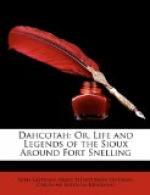Iron Members was on a hill; near which was a deep ravine, when suddenly his eye rested upon something so bright that it pained him to look at it. He looked down the ravine and there stood the Giant. Notwithstanding his position, his head reached to the top of the trees. The Giant was going northwards, and did not notice the Indian or stop; he says he watched the Giant; and, as he went forward, the trees and bushes seemed to make way for him. The visit was one of good luck, the Indians say, for there was excellent hunting that season.
The Dahcotahs believe firmly the story of Iron Members. He was one of their wisest men. He was a great warrior and knew how to kill his enemies. White Dog says that at night, when they were on a war party, Iron Members would extinguish all the fires of the Dahcotahs, and then direct his men where to find the Chippeways. He would take a spoonful of sugar, and the same quantity of whiskey, and make an offering to the spirits of their enemies; he would sing to them, and charm them so that they would come up so close to him that he would knock them on the head with his rattle, and kill them. These spirits approach in the form of a bear. After this is done, they soon find their enemies and conquer them.
The Dahcotahs think their medicine possesses supernatural powers; they burn incense,—leaves of the white cedar tree,—in order to destroy the supernatural powers of a person who dislikes them. They consider the burning of incense a preventive of evil, and believe it wards off danger from lightning. They say that the cedar tree is wahkun (spiritual) and on that account they burn its leaves to ward off danger. The temple of Solomon was built of cedar.
Unktahe, the god of the waters, is much reverenced by the Dahcotahs. Morgan’s bluff, near Fort Snelling, is called “God’s house” by the Dahcotahs; they say it is the residence of Unktahe, and under the hill is a subterranean passage, through which they say the water-god passes when he enters the St. Peter’s. He is said to be as large as a white man’s house.
Near Lac qui parle is a hill called “the Giant’s house.” On one occasion the Rev. Mr. —— was walking with a Dahcotah, and as they approached this hill the Dahcotah exclaimed, “Do you not see him, there he is.” And although no one else saw the Giant, he persisted in watching him for a few moments as he passed over the hill.
Near Lac qui parle, is living an old Dahcotah woman of a singular appearance. Her face is very black, and her hair singed and faded-looking. She was asked by a stranger to account for her singular appearance. “I dreamed of the Giant,” she said; “and I was frightened when I woke; and I told my husband that I would give a dance to the Giant to propitiate him; but my husband said that I was not able to go through the Giant’s dance; that I would only fail, and bring disgrace upon him and all my family. The Giant was very angry with me, and punished me by burning my face black, and my hair as you see it.” Her husband might well fear that she would not be able to perform this dance.




